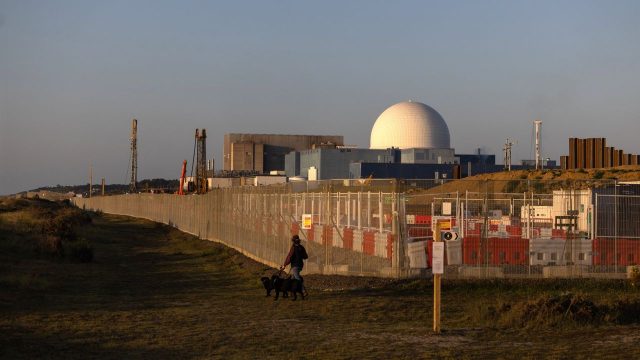
The government aims to quadruple nuclear capacity by 2050, taking it to 24 gigawatts (GW), about a quarter of projected UK annual electricity demand. This year, No. 10 has made a flurry of announcements to show that it is serious about meeting this pledge.
In June, it announced £14.2 billion in funding for the new Sizewell C nuclear plant on the Suffolk coast – in addition to the £3.6 billion committed by the Treasury in the past two years. A month later, investment was finalised, with the government as the largest shareholder. (Meanwhile, Hinkley Point C nuclear power station in Somerset is set to come into service around 2031.) Another £2.5 billion has been allocated to help the development of small modular reactors. Energy Secretary Ed Miliband claims that Britain is about to enter a “golden age” of nuclear power.
Why the urgency now?
Energy use is set to soar, thanks partly to electric vehicles and AI, perhaps doubling by 2050. At present, Britain’s energy costs are some of the highest in Europe, particularly for industry, which is a major drag on the economy. This is partly caused by our dependence on gas, which provides about a third of electricity; ministers want to reduce gas to less than 5% of it by 2030.
Crucially, the government also sees low-carbon nuclear as a way of meeting its target of net-zero emissions by 2050. Wind and solar power are of course intermittent; nuclear power can provide vast amounts of constant “baseload” capacity. Hinkley Point C alone will provide 3.2GW, enough for six million homes, or 7% of current demand.
The trouble is that Britain is running out of time. In 1997, there were 16 nuclear power stations in operation, which together provided 27% of the UK’s electricity; today, only five of our ageing nuclear power stations are still in operation, providing 15% – and four of them are scheduled to close by 2030.
Why has progress halted?
Britain was once a global leader in nuclear power. In 1956, the world’s first commercial nuclear power plant, Calder Hall, opened at Sellafield in Cumbria. Two more opened in 1962. By 1988, the UK had 18 reactors. But most were designed with a maximum lifespan of about 40 years; and the impetus to renew them was lost during Britain’s “dash for gas” in the 1990s.
Meanwhile, high-profile disasters heightened concern over the safety of nuclear energy. And the costs of reactors kept rising: the International Energy Agency has found that nuclear plants built in the US and Europe since 2000 have been on average eight years late, and two-and-a-half times over their original budget; Hinkley Point C’s has ballooned from £18 billion to £46 billion. Britain’s newest reactors now cost four times South Korea’s.
Why are they so expensive?
The UK has struggled to deliver large infrastructure projects within budget for decades now, and nuclear projects are particularly large and complex. They require long-term investment, and both capital and building materials have risen sharply in price. Before Hinkley Point C, no plant had been built since 1995, so skills and supply chains had been lost.
The UK’s planning and regulatory regime is also particularly onerous: at Hinkley Point, 7,000 design changes had to be made to meet regulatory requirements, with the result, its management claims, that the plant will use 25% more steel and 35% more concrete than planned. Plants are required to meet very stringent safety standards; that “there is no safe level of radiation” is an iron rule of the industry. Hinkley Point’s environmental impact assessment ran to 31,401 pages: developers will install underwater loudspeakers (dubbed the “fish disco”) to deter salmon from being poached in the reactor cooling intake.
How do ministers plan to fix this?
Through a combination of planning reforms, regulatory streamlining, investment and the promotion of new technologies. The government has unveiled plans to block campaigners from “excessive” legal challenges to major infrastructure projects, such as nuclear power stations.
It also wants to expand the current list of just eight favoured sites for large nuclear schemes. The expiry date on nuclear planning rules is to be removed, so new projects are no longer “timed out”. And a new Nuclear Regulatory Taskforce is to be set up to improve the regulations. No. 10 hopes these reforms will “clear a path” to allow small modular reactors (SMRs) to be built in locations across the UK.
What are SMRs?
They’re “mini” nuclear power stations, about the size of two football pitches. Their capacity will be about 0.5GW, compared with about 3.2GW for Hinkley Point C. And unlike conventional plants, which are built in situ over years or even decades, they will be built in factories, and then assembled on site.
Rolls-Royce has been chosen by the government to produce the first SMR, by the mid-2030s. It hopes to establish an efficient and relatively cheap production line, allowing power stations to be built in just four years, producing power at about a third of the price of reactors such as Sizewell.
Will all this actually happen?
It will certainly be difficult. Nuclear power’s high upfront costs, poor track record on delivery and spiralling budgets mean that many are sceptical. The planning process will be difficult, and communities affected are likely to resist vociferously. The issue of how to dispose of nuclear waste remains unresolved.
But reliable low-carbon power is needed; and reactors such as Sizewell, though expensive to build, will run for 60 years with relatively low fuel costs. In theory, SMRs could bring prices down – and provide the UK with a significant industry. At any rate, this government is clearly committed to expanding nuclear power. The first SMR site will be announced later this year.
How safe is nuclear power?
A series of high-profile accidents over the years have undermined nuclear power’s safety credentials. In 1957, a reactor caught fire at the Windscale nuclear plant, now known as Sellafield, releasing radioactive material across the UK. In 1979, a reactor at Three Mile Island in Pennsylvania went into partial meltdown following a cooling malfunction. In the Chernobyl disaster of 1986, a reactor exploded at a plant in Soviet Ukraine. And in 2011, a 9.0-magnitude earthquake triggered a meltdown at the Fukushima power plant in Japan; it will take up to 40 years to decontaminate the area.
Nevertheless, the weight of scientific opinion holds that nuclear power is a safe form of power generation. There were no confirmed deaths from Windscale or Three Mile Island, and only one from Fukushima (though all may have caused cancer deaths in the long term). Chernobyl caused perhaps 4,000 deaths, in total. As Tim Gregory, a nuclear chemist at the UK’s National Nuclear Laboratory, notes in his book “Going Nuclear”, nuclear energy accounts for about 0.03 deaths per terawatt hour of generation – equivalent to wind and solar, and far lower than gas or coal. Likewise, “deep geological disposal” is now thought to be a safe solution to the problem of radioactive waste.
The government is promising to ‘fire up nuclear power’. Why, and how?





